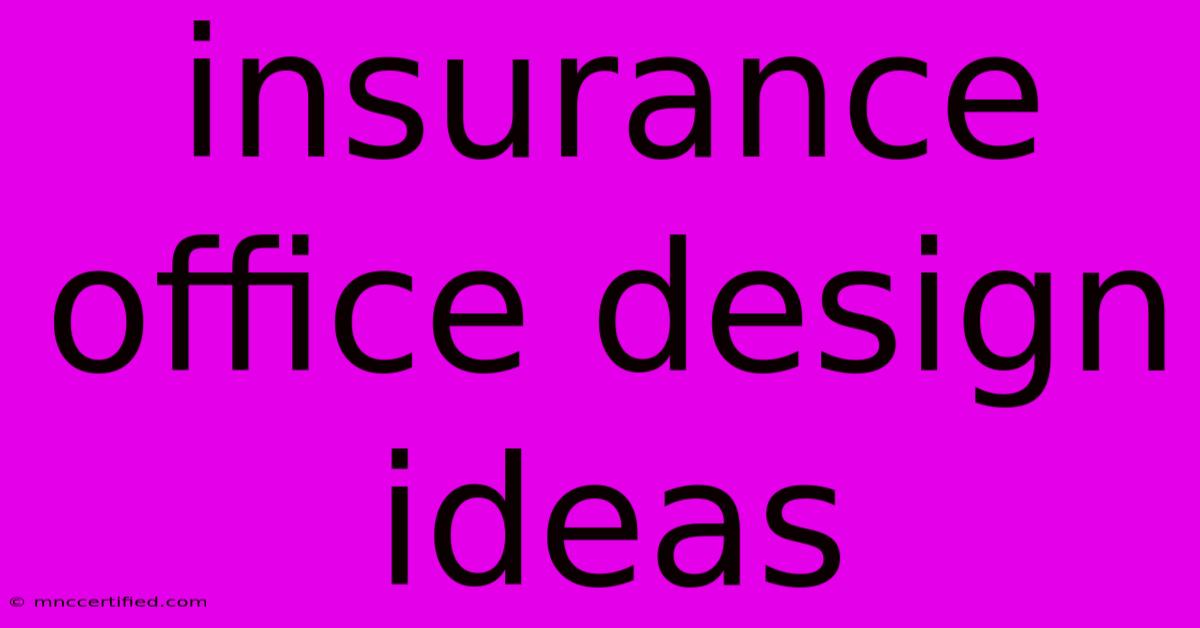Insurance Office Design Ideas

Table of Contents
Insurance Office Design Ideas: Creating a Trustworthy and Welcoming Space
Designing an insurance office goes beyond just finding aesthetically pleasing furniture. It's about crafting a space that inspires trust, comfort, and efficiency – crucial elements for building strong client relationships and fostering a productive work environment. This article dives into innovative insurance office design ideas, focusing on creating an atmosphere that reflects your brand and attracts new business.
Building Trust: The Foundation of Your Design
The insurance industry thrives on trust. Your office design should visually communicate reliability, security, and professionalism. Here's how:
Color Psychology:
- Blues and Greens: These calming colors project stability and trustworthiness. Consider using different shades to create visual interest and avoid a monotonous feel.
- Neutral Tones: Beige, gray, and cream create a sophisticated and neutral backdrop, allowing you to add pops of color with artwork or accessories.
- Avoid: Bright, jarring colors can be distracting and undermine the sense of professionalism.
Furniture Selection:
- High-Quality Materials: Opt for durable, high-quality furniture that conveys longevity and stability. Leather or high-end fabric upholstery adds a touch of luxury.
- Comfortable Seating: Clients should feel comfortable during consultations. Invest in ergonomic chairs and comfortable waiting area seating.
- Minimalist Approach: Cluttered spaces can appear disorganized and unprofessional. A clean, minimalist aesthetic projects efficiency and competence.
Lighting:
- Natural Light: Maximize natural light whenever possible. It creates a more welcoming and positive atmosphere.
- Layered Lighting: Combine ambient, task, and accent lighting to create a warm and inviting ambiance. Avoid harsh fluorescent lighting.
Creating a Welcoming Atmosphere: Beyond the Basics
While professionalism is key, a welcoming atmosphere helps clients feel comfortable and valued.
Reception Area:
- Inviting Seating: Provide comfortable seating with ample space for clients to wait.
- Informative Displays: Consider showcasing your services, client testimonials, or community involvement.
- Technology Integration: A self-service kiosk for initial information or check-in can streamline the process.
Consultation Rooms:
- Privacy: Ensure consultation rooms offer complete privacy for sensitive discussions.
- Technology Integration: Equip rooms with high-quality audio-visual equipment for presentations or virtual meetings.
- Comfortable Ambiance: Use soft lighting, comfortable seating, and potentially add plants to create a relaxing atmosphere.
Boosting Productivity: Designing for Efficiency
Your office design should support the efficient workflows of your team.
Open-Plan vs. Private Offices:
- Open-Plan: Promotes collaboration and communication, but consider using sound-absorbing materials to minimize noise distractions.
- Private Offices: Provide necessary privacy for confidential work and client meetings. A hybrid approach often works best.
Technology Integration:
- High-Speed Internet: Essential for smooth operations and efficient client communication.
- Collaboration Tools: Invest in collaborative technology to streamline workflows and improve team communication.
- Smart Office Technology: Automated lighting, temperature control, and security systems can enhance efficiency.
Branding Your Space: Reflecting Your Company Identity
Your office design should reflect your brand identity and values.
Logo Integration:
- Subtle Branding: Incorporate your logo subtly in design elements, avoiding an overly branded look.
- Color Palette: Use your brand colors to create a cohesive and recognizable space.
Artwork and Decor:
- Local Artists: Showcase artwork from local artists to connect with your community.
- Thematic Decor: Use decor that reflects your company values or target audience.
Off-Page SEO Optimization: Building Your Online Presence
While interior design is crucial, don't neglect your online presence. Off-page SEO strategies are essential:
- Local SEO: Optimize your Google My Business profile with accurate information and high-quality photos of your office.
- Online Reviews: Encourage satisfied clients to leave positive reviews on platforms like Google, Yelp, and Facebook.
- Social Media Marketing: Showcase your office design and company culture on social media platforms.
- Link Building: Obtain high-quality backlinks from relevant websites in the insurance and design industries.
By focusing on these design ideas and incorporating strong off-page SEO strategies, you can create an insurance office that's not only aesthetically pleasing but also efficient, welcoming, and a powerful reflection of your brand. Remember that a well-designed office is an investment in your clients and your team, ultimately leading to increased success.

Thank you for visiting our website wich cover about Insurance Office Design Ideas. We hope the information provided has been useful to you. Feel free to contact us if you have any questions or need further assistance. See you next time and dont miss to bookmark.
Featured Posts
-
Toothache No Dental Insurance
Nov 29, 2024
-
Dui Accident Insurance Claims
Nov 29, 2024
-
Home Insurance Ponte Vedra Fl
Nov 29, 2024
-
Good Friends Insurance Agency
Nov 29, 2024
-
Choice Insurance Phone Number
Nov 29, 2024